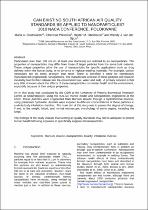JavaScript is disabled for your browser. Some features of this site may not work without it.
- ResearchSpace
- →
- Research Publications/Outputs
- →
- Conference Publications
- →
- View Item
| dc.contributor.author |
Oosthuizen, MA

|
|
| dc.contributor.author |
Pretorius, E

|
|
| dc.contributor.author |
Oberholzer, HM

|
|
| dc.contributor.author |
Van der Spuy, WJ

|
|
| dc.date.accessioned | 2010-11-05T08:55:48Z | |
| dc.date.available | 2010-11-05T08:55:48Z | |
| dc.date.issued | 2010-10 | |
| dc.identifier.citation | Oosthuizen, MA, Pretorius, E, Oberholzer, HM and Van der Spuy, WJ. 2010. Can existing South African air quality standards be applied to nanoparticles?. Bridging the gap; 2010 National Association for Clean Air (NACA) Annual Conference, Polokwane, 13-15 October 2010, pp 5 | en |
| dc.identifier.uri | http://hdl.handle.net/10204/4527 | |
| dc.description | Bridging the gap; 2010 National Association for Clean Air (NACA) Annual Conference, Polokwane, 13-15 October 2010 | en |
| dc.description.abstract | Particulates less than 100 nm (in at least one diameter) are referred to as nanoparticles. The properties of nanoparticles may differ from those of larger particles from the same bulk material. These unique properties allow the use of nanoparticles for specific applications such as drug delivery within the human body, or to enhance or replace existing materials. For example, carbon nanotubes are six times stronger than steel. There is therefore a need for intentionally manufactured (engineered) nanoparticles. The manufacture and use of these particles will however inevitably lead to their release into the environment (air, water and soil). A primary concern is that very little is known about the effects of these nanoparticles on human health and the environment, especially because of their unique properties. An in vivo study was conducted by the CSIR at the University of Pretoria Biomedical Research Centre at Onderstepoort, using the BALB/c murine model and nanoparticles engineered at the CSIR. These particles were engineered from titanium dioxide through a hydrothermal process, using potassium hydroxide. Animals were exposed to different concentrations of these particles in a whole-body inhalation chamber. The main aim of this study was to assess the degree of change, if any, to the weight, blood, and normal microscopic morphology of some organs, including the lungs. The findings of the study indicate that existing air quality standards may not be adequate to protect human health following exposure to specifically engineered nanoparticles | en |
| dc.language.iso | en | en |
| dc.relation.ispartofseries | Conference Paper | en |
| dc.subject | Titanium | en |
| dc.subject | Dioxide | en |
| dc.subject | Nanoparticles | en |
| dc.subject | Toxicity | en |
| dc.subject | Air inhalation | en |
| dc.subject | Air quality | en |
| dc.subject | National Association for Clean Air | en |
| dc.subject | NACA | en |
| dc.subject | Clean air | en |
| dc.title | Can existing South African air quality standards be applied to nanoparticles? | en |
| dc.type | Conference Presentation | en |
| dc.identifier.apacitation | Oosthuizen, M., Pretorius, E., Oberholzer, H., & Van der Spuy, W. (2010). Can existing South African air quality standards be applied to nanoparticles?. http://hdl.handle.net/10204/4527 | en_ZA |
| dc.identifier.chicagocitation | Oosthuizen, MA, E Pretorius, HM Oberholzer, and WJ Van der Spuy. "Can existing South African air quality standards be applied to nanoparticles?." (2010): http://hdl.handle.net/10204/4527 | en_ZA |
| dc.identifier.vancouvercitation | Oosthuizen M, Pretorius E, Oberholzer H, Van der Spuy W, Can existing South African air quality standards be applied to nanoparticles?; 2010. http://hdl.handle.net/10204/4527 . | en_ZA |
| dc.identifier.ris | TY - Conference Presentation AU - Oosthuizen, MA AU - Pretorius, E AU - Oberholzer, HM AU - Van der Spuy, WJ AB - Particulates less than 100 nm (in at least one diameter) are referred to as nanoparticles. The properties of nanoparticles may differ from those of larger particles from the same bulk material. These unique properties allow the use of nanoparticles for specific applications such as drug delivery within the human body, or to enhance or replace existing materials. For example, carbon nanotubes are six times stronger than steel. There is therefore a need for intentionally manufactured (engineered) nanoparticles. The manufacture and use of these particles will however inevitably lead to their release into the environment (air, water and soil). A primary concern is that very little is known about the effects of these nanoparticles on human health and the environment, especially because of their unique properties. An in vivo study was conducted by the CSIR at the University of Pretoria Biomedical Research Centre at Onderstepoort, using the BALB/c murine model and nanoparticles engineered at the CSIR. These particles were engineered from titanium dioxide through a hydrothermal process, using potassium hydroxide. Animals were exposed to different concentrations of these particles in a whole-body inhalation chamber. The main aim of this study was to assess the degree of change, if any, to the weight, blood, and normal microscopic morphology of some organs, including the lungs. The findings of the study indicate that existing air quality standards may not be adequate to protect human health following exposure to specifically engineered nanoparticles DA - 2010-10 DB - ResearchSpace DP - CSIR KW - Titanium KW - Dioxide KW - Nanoparticles KW - Toxicity KW - Air inhalation KW - Air quality KW - National Association for Clean Air KW - NACA KW - Clean air LK - https://researchspace.csir.co.za PY - 2010 T1 - Can existing South African air quality standards be applied to nanoparticles? TI - Can existing South African air quality standards be applied to nanoparticles? UR - http://hdl.handle.net/10204/4527 ER - | en_ZA |






